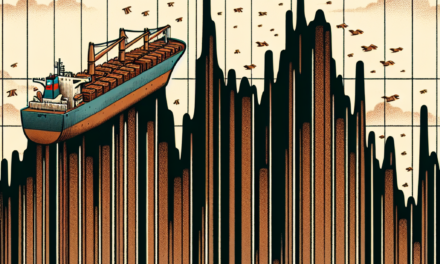“Wall Street Dips: A Silver Lining Amidst Inflation Worries.”
Introduction
Wall Street experienced a notable dip as positive economic news emerged, raising concerns about potential inflation. Despite signs of economic growth, such as robust job creation and increased consumer spending, investors reacted cautiously to the implications these developments could have on monetary policy. The prospect of rising inflation often leads to speculation about interest rate hikes, prompting market volatility. As traders grapple with the balance between encouraging economic indicators and the risks of overheating, the stock market reflects a complex interplay of optimism and caution.
Wall Street Dips: A Sign of Market Correction
In recent trading sessions, Wall Street has experienced a notable dip, a development that has raised eyebrows among investors and analysts alike. This decline comes on the heels of positive economic news, which, paradoxically, has sparked renewed concerns about inflation. As the economy shows signs of resilience, the implications for monetary policy and market stability become increasingly complex. The juxtaposition of encouraging economic indicators with fears of rising prices creates a volatile environment that can lead to market corrections.
The recent economic data, which includes robust job growth and increased consumer spending, initially painted a picture of a thriving economy. However, such positive developments often lead to speculation about the Federal Reserve’s next moves regarding interest rates. When the economy performs well, the central bank may feel compelled to tighten monetary policy to prevent overheating, which can, in turn, lead to inflationary pressures. This potential shift in policy has caused investors to reassess their positions, leading to a sell-off in equities as they seek to mitigate risk.
Moreover, the market’s reaction to this economic news underscores a broader trend of heightened sensitivity to inflationary signals. Investors are acutely aware that even a hint of rising prices can prompt the Federal Reserve to act decisively, potentially stifling economic growth. Consequently, the fear of inflation has become a significant driver of market sentiment, influencing trading decisions and leading to increased volatility. As a result, the recent dip in Wall Street can be interpreted as a market correction, reflecting a recalibration of expectations in light of the evolving economic landscape.
In addition to the immediate impact of economic data, external factors also play a crucial role in shaping market dynamics. Geopolitical tensions, supply chain disruptions, and fluctuations in commodity prices can all contribute to inflationary pressures. For instance, rising energy costs have been a persistent concern, as they can ripple through the economy, affecting everything from transportation to consumer goods. As these external factors intertwine with domestic economic indicators, they create a complex web of influences that can lead to unpredictable market movements.
Furthermore, the psychological aspect of investing cannot be overlooked. Market participants often react not only to hard data but also to sentiment and speculation. The fear of inflation can lead to a self-fulfilling prophecy, where investors pull back on spending and investment in anticipation of rising prices. This behavior can exacerbate market corrections, as selling begets more selling, creating a downward spiral that can be difficult to reverse.
As Wall Street navigates this challenging terrain, it is essential for investors to remain vigilant and informed. Understanding the interplay between economic indicators, monetary policy, and market sentiment is crucial for making sound investment decisions. While the recent dip may signal a correction, it also presents opportunities for those who can discern the underlying trends and position themselves accordingly. In this environment of uncertainty, a measured approach that balances risk and opportunity will be vital for navigating the complexities of the current market landscape.
In conclusion, the recent dip in Wall Street serves as a reminder of the delicate balance between positive economic news and inflation concerns. As investors grapple with the implications of a potentially tightening monetary policy, the market’s response highlights the intricate relationship between economic performance and investor sentiment. Ultimately, staying informed and adaptable will be key for those looking to thrive in this ever-evolving financial landscape.
Positive Economic News: Implications for Investors
In recent weeks, a series of positive economic indicators has emerged, prompting discussions among investors about the potential implications for the financial markets. While robust job growth, rising consumer spending, and increased manufacturing output are generally viewed as signs of a healthy economy, they also raise concerns about inflationary pressures. As the economy shows signs of resilience, investors must navigate the delicate balance between optimism and caution, particularly in light of the Federal Reserve’s ongoing efforts to manage inflation.
The recent uptick in economic activity has led to a renewed sense of confidence among consumers and businesses alike. For instance, the labor market has demonstrated remarkable strength, with unemployment rates remaining at historically low levels. This has resulted in increased disposable income for households, which in turn fuels consumer spending. As consumers feel more secure in their financial situations, they are more likely to make significant purchases, thereby driving demand across various sectors. However, this surge in demand can lead to supply constraints, which may exacerbate inflationary pressures.
Moreover, the manufacturing sector has also shown signs of improvement, with production levels rising and supply chain disruptions gradually easing. This resurgence in manufacturing not only contributes to economic growth but also raises questions about the sustainability of this momentum. As companies ramp up production to meet growing demand, they may face rising costs for raw materials and labor. These increased costs could ultimately be passed on to consumers, further fueling inflation and prompting the Federal Reserve to reconsider its monetary policy stance.
In light of these developments, investors are faced with a complex landscape. On one hand, the positive economic news suggests that corporate earnings may continue to grow, which could support stock prices. On the other hand, the specter of rising inflation poses a significant risk to market stability. As inflation expectations rise, investors may begin to reassess their portfolios, leading to increased volatility in the stock market. This uncertainty can create challenges for those seeking to make informed investment decisions.
Furthermore, the Federal Reserve’s response to these economic indicators will play a crucial role in shaping market dynamics. If the central bank perceives that inflation is becoming entrenched, it may opt to raise interest rates more aggressively than previously anticipated. Such a move could dampen economic growth and lead to a reevaluation of asset valuations across the board. Consequently, investors must remain vigilant and adaptable, closely monitoring economic data and Fed communications to gauge the potential impact on their investments.
In conclusion, while positive economic news can be a source of optimism for investors, it is essential to remain cognizant of the potential implications for inflation and monetary policy. The interplay between economic growth and inflationary pressures creates a challenging environment for investment decision-making. As the landscape continues to evolve, investors must strike a balance between capitalizing on growth opportunities and safeguarding their portfolios against the risks associated with rising inflation. By staying informed and agile, investors can better navigate the complexities of the current economic climate and position themselves for long-term success.
Inflation Concerns: Understanding the Impact on Stocks
In recent weeks, Wall Street has experienced fluctuations, particularly in response to positive economic news that has simultaneously sparked concerns about inflation. As investors digest the implications of robust economic indicators, it becomes essential to understand how inflation concerns can impact stock markets. The relationship between economic growth and inflation is complex, and it often leads to a reevaluation of asset values, particularly in the equity markets.
When economic data, such as employment figures or consumer spending, shows signs of strength, it typically signals a growing economy. However, this growth can also lead to inflationary pressures. As demand for goods and services increases, prices may rise, prompting concerns among investors about the potential for the Federal Reserve to intervene by raising interest rates. Higher interest rates can dampen economic growth by making borrowing more expensive, which in turn can negatively affect corporate profits and, consequently, stock prices.
Moreover, inflation erodes purchasing power, which can lead to decreased consumer spending. When consumers face higher prices, they may cut back on discretionary spending, impacting businesses that rely on consumer demand. This potential slowdown in spending can create a ripple effect throughout the economy, leading to lower earnings forecasts for companies and, ultimately, a decline in stock valuations. As a result, investors often react to inflation news by reassessing their portfolios, leading to increased volatility in the stock market.
Additionally, sectors of the economy respond differently to inflationary pressures. For instance, companies in the consumer staples sector, which produce essential goods, may fare better during inflationary periods as consumers prioritize necessary purchases. Conversely, growth-oriented sectors, such as technology, may suffer as higher interest rates can diminish the present value of future earnings. This divergence can lead to sector rotation within the stock market, where investors shift their focus from high-growth stocks to more stable, dividend-paying companies.
Furthermore, the bond market also plays a crucial role in shaping investor sentiment regarding inflation. When inflation expectations rise, bond yields tend to increase as investors demand higher returns to compensate for the diminishing purchasing power of future interest payments. This rise in yields can lead to a shift in capital from equities to fixed-income securities, further contributing to stock market declines. As investors weigh the risks associated with inflation against the potential for continued economic growth, the interplay between these two factors becomes increasingly significant.
In light of these dynamics, it is essential for investors to remain vigilant and informed about economic indicators and their potential implications for inflation. Understanding the broader economic landscape can help investors make more informed decisions regarding their portfolios. While positive economic news is generally welcomed, it is crucial to consider the potential consequences of rising inflation and interest rates on stock valuations. As the market continues to react to these developments, maintaining a balanced perspective will be key to navigating the complexities of investing in an environment marked by inflation concerns. Ultimately, the interplay between economic growth and inflation will continue to shape the investment landscape, requiring investors to adapt their strategies in response to evolving market conditions.
The Relationship Between Economic Growth and Market Volatility
The relationship between economic growth and market volatility is a complex and often paradoxical one, characterized by a delicate balance between optimism and caution. As economies expand, the potential for increased corporate profits typically leads to higher stock prices, fostering a sense of confidence among investors. However, this growth can also trigger concerns about inflation, which in turn can lead to market fluctuations. When positive economic news emerges, such as robust job creation or rising consumer spending, it can initially buoy market sentiment. Yet, as investors digest the implications of such data, fears of overheating and subsequent inflationary pressures often surface, resulting in a dip in stock prices.
This dynamic is particularly evident in the context of recent economic indicators that have shown signs of resilience. For instance, when unemployment rates fall and consumer confidence rises, the expectation is that spending will increase, driving demand for goods and services. While this scenario is generally favorable for businesses, it can also lead to higher prices as demand outstrips supply. Consequently, the prospect of rising inflation can prompt central banks to consider tightening monetary policy, which may include raising interest rates. Such actions are intended to cool down an overheating economy but can also lead to increased borrowing costs for consumers and businesses alike, thereby dampening economic growth.
Moreover, the stock market is inherently forward-looking, meaning that investors often react not just to current economic conditions but also to anticipated future developments. When positive economic news is released, the initial reaction may be one of enthusiasm, pushing stock prices higher. However, as the implications of that news are fully assessed, concerns about inflation and potential interest rate hikes can lead to a rapid reassessment of valuations. This phenomenon illustrates the volatility that can arise from the interplay between economic growth and inflationary fears, as investors weigh the benefits of a thriving economy against the risks of rising prices.
Additionally, market volatility can be exacerbated by external factors, such as geopolitical tensions or supply chain disruptions, which can further complicate the relationship between economic growth and market stability. For instance, if a country experiences strong economic growth but is simultaneously facing trade disputes or political instability, investor confidence may wane, leading to increased market fluctuations. In such scenarios, the potential for economic growth may be overshadowed by fears of uncertainty, prompting investors to adopt a more cautious approach.
In conclusion, the relationship between economic growth and market volatility is characterized by a constant tug-of-war between optimism and caution. While positive economic indicators can initially boost market sentiment, they can also raise concerns about inflation and the potential for tighter monetary policy. This duality creates an environment where market volatility is a natural byproduct of economic expansion. As investors navigate this landscape, they must remain vigilant, balancing the allure of growth with the realities of inflationary pressures and external uncertainties. Ultimately, understanding this intricate relationship is crucial for making informed investment decisions in an ever-evolving economic landscape.
Strategies for Navigating Wall Street Dips Amid Inflation Fears
As Wall Street experiences fluctuations in response to positive economic news, investors are increasingly concerned about the potential for rising inflation. This scenario presents a unique challenge for those navigating the complexities of the stock market. To effectively manage investments during periods of volatility, it is essential to adopt strategies that not only mitigate risk but also capitalize on opportunities that may arise from changing economic conditions.
One of the first strategies to consider is diversification. By spreading investments across various asset classes, sectors, and geographic regions, investors can reduce the impact of a downturn in any single area. For instance, while equities may be under pressure due to inflation fears, other asset classes such as commodities or real estate may perform well. This approach not only helps to cushion the blow of market dips but also positions investors to benefit from sectors that may thrive in an inflationary environment.
In addition to diversification, maintaining a long-term perspective is crucial. Market fluctuations can be unsettling, particularly when driven by economic indicators that suggest inflation may be on the rise. However, history has shown that markets tend to recover over time. By focusing on long-term goals rather than short-term volatility, investors can avoid making impulsive decisions that may lead to losses. This perspective encourages a disciplined approach, allowing investors to ride out temporary dips while remaining committed to their overall investment strategy.
Furthermore, it is important to stay informed about economic trends and indicators that could signal changes in inflation. Monitoring key metrics such as consumer price index (CPI) data, wage growth, and central bank policies can provide valuable insights into the inflation landscape. By understanding these factors, investors can make more informed decisions about when to enter or exit positions. For example, if inflation is expected to rise, it may be prudent to consider reallocating assets toward sectors that historically perform well during inflationary periods, such as energy or materials.
Another effective strategy is to consider the use of inflation-hedged investments. These can include Treasury Inflation-Protected Securities (TIPS), which are designed to provide protection against inflation by adjusting the principal value based on changes in the CPI. Additionally, investing in commodities, such as gold or oil, can serve as a hedge against inflation, as their prices often rise when inflationary pressures increase. By incorporating these types of assets into a portfolio, investors can better safeguard their investments against the erosive effects of inflation.
Moreover, maintaining liquidity is essential during periods of market uncertainty. Having readily accessible cash or cash-equivalents allows investors to take advantage of buying opportunities that may arise during market dips. This strategy not only provides flexibility but also reduces the need to sell other investments at a loss during downturns. By being prepared to act when opportunities present themselves, investors can enhance their potential for long-term gains.
In conclusion, navigating Wall Street dips amid inflation fears requires a multifaceted approach that emphasizes diversification, a long-term perspective, informed decision-making, inflation-hedged investments, and maintaining liquidity. By implementing these strategies, investors can better position themselves to weather market volatility while capitalizing on potential opportunities that arise in an evolving economic landscape. Ultimately, a proactive and informed approach can help investors not only survive but thrive in challenging market conditions.
Historical Context: Wall Street Dips and Economic Indicators
In recent years, Wall Street has experienced a series of fluctuations that reflect the complex interplay between economic indicators and investor sentiment. The relationship between positive economic news and market performance is often intricate, as evidenced by the recent dip in stock prices following reports of robust job growth and rising consumer spending. This phenomenon can be traced back through history, where similar patterns have emerged during periods of economic expansion. Investors frequently grapple with the duality of good news, which can simultaneously signal growth and raise concerns about inflation.
Historically, Wall Street’s reactions to economic indicators have been shaped by the prevailing economic climate. For instance, during the late 1990s, the U.S. economy experienced a significant boom characterized by technological advancements and increased productivity. While this period was marked by rising stock prices, it also raised fears of overheating, leading to inflationary pressures. As a result, the Federal Reserve was compelled to adjust interest rates to temper growth, a move that ultimately influenced market dynamics. This historical context underscores the delicate balance that investors must navigate when interpreting economic data.
Moreover, the relationship between inflation and economic growth has been a recurring theme in financial markets. In the early 2000s, the aftermath of the dot-com bubble saw a similar scenario unfold. Positive economic indicators, such as increased consumer confidence and spending, initially buoyed stock prices. However, as inflationary concerns began to surface, the market reacted negatively, leading to a decline in stock values. This pattern illustrates how investors often respond to the potential for rising prices by reassessing their risk exposure, which can result in market volatility.
Transitioning to the present, the recent dip in Wall Street can be attributed to a confluence of factors, including strong economic data that has reignited fears of inflation. Reports indicating a surge in employment and consumer spending have led many analysts to speculate about the possibility of the Federal Reserve tightening monetary policy. Such speculation can create uncertainty in the markets, prompting investors to reevaluate their positions. Consequently, even positive economic news can trigger a sell-off as market participants seek to mitigate potential risks associated with rising interest rates.
Furthermore, the historical context of Wall Street’s reactions to economic indicators reveals a pattern of cyclical behavior. During periods of economic expansion, investors often exhibit optimism, driving stock prices higher. However, as inflationary pressures mount, this optimism can quickly turn to caution, resulting in market corrections. This cyclical nature is evident in the current landscape, where the interplay between economic growth and inflation continues to shape investor sentiment.
In conclusion, the recent dip in Wall Street serves as a reminder of the intricate relationship between positive economic news and inflation concerns. Historical patterns reveal that while strong economic indicators can initially boost market confidence, they can also lead to heightened anxiety about rising prices and potential interest rate hikes. As investors navigate this complex landscape, understanding the historical context of market reactions to economic data becomes essential. Ultimately, the delicate balance between growth and inflation will continue to influence Wall Street’s trajectory, underscoring the importance of vigilance in an ever-evolving economic environment.
Expert Insights: What Wall Street Dips Mean for the Future
As Wall Street experiences a dip in response to positive economic news, the implications for the future become a focal point of discussion among financial experts. The recent fluctuations in the stock market, driven by reports of robust job growth and increased consumer spending, have raised concerns about potential inflationary pressures. While positive economic indicators are typically welcomed, the current environment suggests a complex interplay between growth and inflation that could shape market dynamics in the coming months.
Experts note that the strong economic data, while encouraging, has led to heightened fears of inflation, prompting investors to reassess their positions. The Federal Reserve’s ongoing efforts to manage inflation through interest rate adjustments are central to this conversation. As the central bank navigates the delicate balance between fostering economic growth and curbing inflation, market participants are left to ponder the potential consequences of these policy decisions. The recent dip in stock prices may reflect a broader anxiety regarding the Fed’s ability to maintain this balance without triggering a recession.
Moreover, the relationship between interest rates and stock market performance cannot be overlooked. Historically, rising interest rates have led to increased borrowing costs, which can dampen consumer spending and business investment. Consequently, as the Fed signals its intent to combat inflation, investors may become increasingly cautious, leading to volatility in equity markets. This cautious sentiment is evident in the recent market movements, where positive economic news has paradoxically resulted in declines, as investors weigh the implications of tighter monetary policy.
In addition to interest rates, supply chain disruptions and geopolitical tensions further complicate the economic landscape. These factors contribute to inflationary pressures that can erode consumer purchasing power and impact corporate profitability. As companies grapple with rising costs, the potential for reduced earnings growth looms large, prompting investors to reevaluate their expectations for future performance. This uncertainty can lead to increased market volatility, as seen in the recent dip, where positive economic indicators were overshadowed by concerns about inflation and its potential impact on corporate earnings.
Looking ahead, experts suggest that investors should remain vigilant and adaptable in the face of these evolving economic conditions. The ability to pivot in response to new information will be crucial as the market navigates the dual challenges of growth and inflation. Diversification may become an essential strategy for mitigating risk, as sectors of the economy respond differently to changing interest rates and inflationary pressures. For instance, while technology stocks may face headwinds from rising rates, sectors such as energy and consumer staples could benefit from inflationary trends.
In conclusion, the recent dip in Wall Street serves as a reminder of the intricate relationship between economic indicators and market sentiment. As positive news raises inflation concerns, investors must remain attuned to the broader economic landscape and the Federal Reserve’s policy responses. The interplay between growth, inflation, and market performance will undoubtedly shape investment strategies in the near future. By staying informed and adaptable, investors can better navigate the complexities of the current economic environment, positioning themselves for potential opportunities amidst the challenges that lie ahead.
Q&A
1. **Question:** What recent event caused Wall Street to dip?
**Answer:** Positive economic news, such as strong job growth or rising consumer spending, raised concerns about potential inflation.
2. **Question:** How does positive economic news relate to inflation concerns?
**Answer:** Strong economic indicators can lead to increased demand, which may drive prices up, raising inflation fears.
3. **Question:** What impact do inflation concerns have on the stock market?
**Answer:** Inflation concerns can lead to higher interest rates, which typically result in lower stock prices as borrowing costs increase.
4. **Question:** Which sectors are most affected by inflation concerns?
**Answer:** Sectors such as consumer discretionary, technology, and utilities are often most sensitive to inflation and interest rate changes.
5. **Question:** How do investors typically react to Wall Street dips caused by inflation fears?
**Answer:** Investors may sell off stocks to mitigate risk, leading to further declines in the market.
6. **Question:** What measures can the Federal Reserve take in response to inflation concerns?
**Answer:** The Federal Reserve may raise interest rates or reduce asset purchases to combat rising inflation.
7. **Question:** What is the long-term outlook for the stock market amid inflation concerns?
**Answer:** The long-term outlook can vary; if inflation is controlled, the market may recover, but persistent inflation could lead to sustained volatility.
Conclusion
The recent dip in Wall Street can be interpreted as a response to positive economic news that has raised concerns about inflation. While strong economic indicators typically bolster market confidence, the potential for rising inflation can lead to uncertainty among investors, prompting sell-offs. This situation highlights the delicate balance between economic growth and inflationary pressures, suggesting that while the economy may be improving, the implications for monetary policy and market stability remain complex and warrant close attention.





